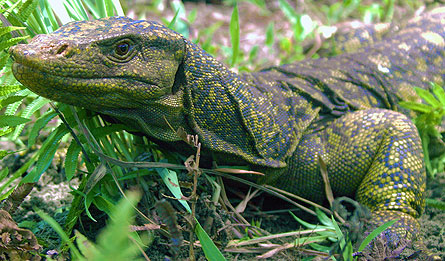Scientists couldn’t see the lizard for the trees.

But now they’ve tracked down and named Varanus bitatawa, a skittish reptile that’s hard to spot even though it grows up to 2 meters long and sports bright yellow speckles.
In forests on the Philippine island of Luzon, the newly discovered monitor lizard hauls itself up into trees in search of fruit and melts into the vegetation if humans approach, says herpetologist Rafe Brown of the Biodiversity Institute at the University of Kansas in Lawrence. He and his colleagues describe and name the species in a paper published online the week of April 5 in Biology Letters.
The species is “new to us,” Brown clarifies, because the Agta and Ilongot peoples living in forests of the Sierra Madre range know the lizard well — as a delicacy. It mostly eats fruit and reportedly tastes better than a much more common scavenging monitor that’s “attracted to stinky stuff,” Brown says.
A cousin to the giant Komodo dragon, Varanus bitatawa is hard to find but once detected, is pretty hard to ignore. During adulthood, yellow markings differentiate it from a much drabber neighbor — though both species sport colorful patterns as juveniles.
Reptile systematist Michael B. Harvey, who was not part of Brown’s group, has helped name another Varanus lizard from New Guinea and examined specimens from Southeast Asia. “I quickly realized that diversity of these lizards had been greatly underestimated,” says Harvey, of Broward College in Davie, Fla. “I only hope that we don’t lose much of this biodiversity before scientists can study it.”
Deforestation poses a major threat to the biodiversity of the Philippines, which Brown and his colleagues describe in their paper as a “global conservation hotspot.”
Western scientists first glimpsed the big monitor in 2001, Brown says, when biologists exploring the forest happened on hunters carrying a large lizard home for dinner. The biologists were permitted to photograph it, but theirs was the first of several encounters in which hunters showed no interest in giving up the centerpiece of a big family meal.
Herpetologist Arvin Diesmos of the National Museum of the Philippines in Manila and other researchers persisted in collecting photographs, local intelligence and the occasional juvenile, but they could not secure a full-grown adult specimen.
Then, in the summer of 2009, a team led by Brown and his graduate student Luke Welton got its hands on an adult lizard. They documented identifying anatomical characteristics such as the distinctive little horns on the ends of the lizards’ double-barreled male reproductive organs. Which, by the way, are far from unusual in and of themselves: “All snakes and lizards have a paired copulatory organ,” Brown says.
DNA tests were even more important, confirming that the species differs from a previously identified fruit-eating monitor living in a different part of the island.
Brown actually learned of the adult specimen’s existence via text message. After he and his students spent weeks in the mountains surveying other vertebrates and hoping for an adult Varanus bitatawa, Brown had to return home early to start the fall semester. But he received a message from his students in the expedition’s final hours announcing their success — and letting him know that they were having a hard time finding a way to get from their camp to the airport.






